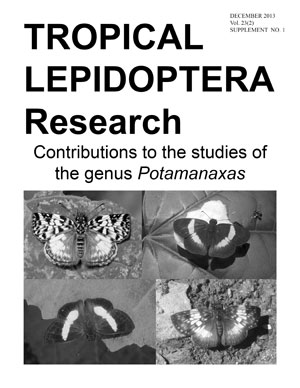Two new species of Potamanaxas (Hesperiidae: Pyrginae: Erynnini)—one of them,P. melicertes of Evans, was mentioned but not named by Godman and Salvin.
Keywords:
taxonomy, skipper butterfly, Neotropics, cryptic species, genitaliaAbstract
When primary type specimens are not available for analysis by a reviser, mistakes may occur. Examination of the Potamanaxas melicertes (Godman & Salvin, 1895) holotype and the original description suggest that the species W. H. Evans mistook for it is new, described here from Colombia (type locality) and Ecuador as P. tschotky, sp. nov. It differs from P. melicertes in the shape and extent of discal white band on both wings as well as the details of its submarginal pattern. This species (from Ecuador) was apparently mentioned but not named by Godman and Salvin just prior to the description of P. melicertes (from Panama). Yet an additional new species with restricted white band on the hindwing, described here as P. okroogly, sp. nov., is found in Peru (type locality) and Bolivia. Its male genitalia imply close relationship with P. thoria (Hewitson, 1870). Primary types of relevant taxa are illustrated.
Cuando espécimenes de tipo primario no están disponibles para ser analizados por un revisor, pueden ocurrir errores. La inspección del holotipo de Potamanaxas melicertes (Godman y Salvin, 1895) y su descripción original sugiere que la especie con la que W. H. Evans la confundió es nueva, se describe aquí desde Colombia (tipo de localidad) y Ecuador como P. tschotky, sp. nov. Se diferencia de P. melicertes tanto en la forma y la extensión de la banda blanca discal en ambas alas como en los detalles del patrón submarginal. Esta especie (de Ecuador), según parece, fue mencionada (pero no nombrada) por Godman y Salvin justo antes de su descripción de P. melicertes (de Panamá). Una otra especie nueva con una banda blanca restringida en las alas posteriores, descrito aquí como P. okroogly, sp. nov., se halla en Perú (tipo de localidad) y Bolivia. Su genitales masculinos implican estrecha relación con P. thoria (Hewitson, 1870). Especímenes de tipo primario de taxones relevantes son ilustrados.

